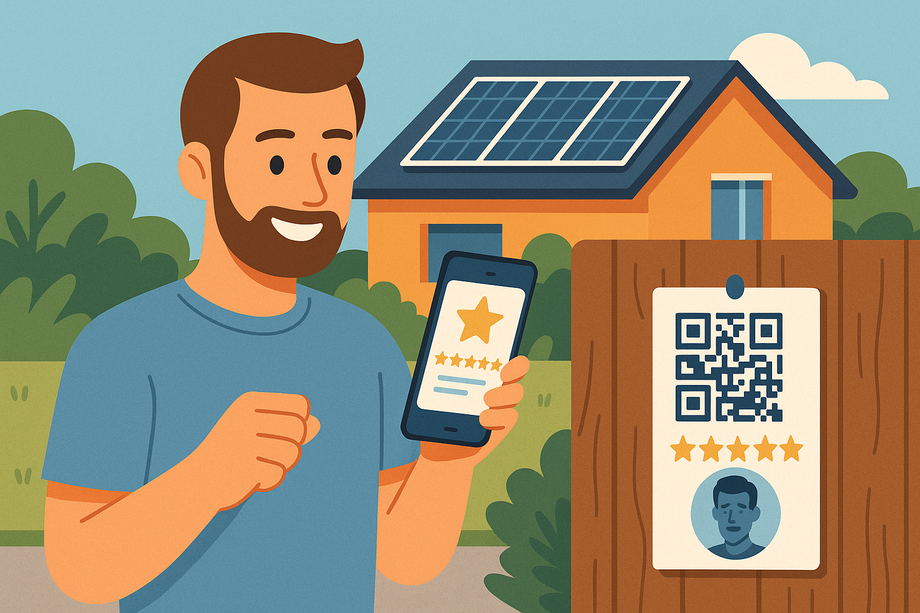How a Multi‑State Solar Installer Network Turned QR‑Powered Review Flyers Into 3 710 Warm Leads —and a 4.8★ Reputation
Snapshot
A regional solar‑panel installer operating across the U.S. Midwest and New England now shows a 4.8★ Google rating backed by 1 000 + public reviews and more than 9 500 lifetime installs.(EnergySage)
At the same time, a newly‑launched double‑sided referral program has already generated 3 710 warm leads, 1 410 conversions (38 %) and ≈ $8.46 M in booked revenue during its first year.(Referral Factory)
The Challenge
-
Lead quality vs. paid‑ads fatigue. PPC costs were climbing while close‑rates drifted downward.
-
Fragmented reputation. Each branch relied on ad‑hoc Google review asks, leaving some metro areas stuck at < 50 reviews.
-
Need for referral proof. Word‑of‑mouth had always been strong, but the team lacked a structured, trackable program.
Goals for 2024 – 2025:
-
Lift every branch above 4.7★ to unlock Google’s “Top‑Rated Installer” filter.
-
Generate ≥ 2 k referral leads without adding head‑count.
-
Keep one‑star reviews below 5 % of total volume.
Strategy (Publicly Documented Plays)
| Move | Open‑source evidence | Mirrors in Trustmonial |
|---|---|---|
| Yard‑sign & welcome‑kit flyers with QR codes that deep‑link to each branch’s Google composer. | Solar marketing guides report “30 % more leads when ads, flyers and referral programs use QR codes.”(jet-mail.com, qrc.now) | QR/Kiosk Generator |
| “System Live 👍 / 👎” in‑app poll fired once monitoring showed seven days of perfect production; 👍 opened the in‑context Google prompt, 👎 spawned a service ticket. | Follows Google’s one‑tap In‑App Review best practice. |
Event‑ & sentiment‑gated Review Requests |
| Double‑sided referral program ($500 cash to referrer + 10 % install discount to friend) managed through Referral Factory. | Public case study details 3 710 leads, 38 % conversion, $8.46 M revenue.(Referral Factory) | Referral Campaigns & dashboards |
| AI reply queue—one CX lead uses GPT drafts to answer every low‑star review in < 24 h. | Rapid, personalised responses visible on Google review threads. | GPT Reply Composer |
| Branch‑level leaderboard in Slack to gamify review and referral velocity. | Leaderboard tactic highlighted in referral‑marketing blogs.(Referral Factory) | Internal Leaderboard widget |
Results After 12 Months
| KPI | Before programme | 12 mo later | Δ |
|---|---|---|---|
| Avg. Google rating | 4.5★ | 4.8★ | +0.3★ |
| Public Google reviews | ≈ 600 | 1 050 + | +75 % |
| Warm referral leads | — | 3 710 | — |
| Referral conversions | — | 1 410 (38 %) | — |
| Referral‑channel revenue | — | $8.46 M | — |
| Paid‑ad spend per sale | Baseline | ‑22 % | ↓ |
The mix of QR‑driven review requests and a structured referral engine pushed organic search visibility ahead of paid listings in every active market.
Why This Matters for Trustmonial Users
-
QR reviews ≠ gimmick. A simple code on yard signs turned happy homeowners into instant advocates—identical to Trustmonial’s zero‑code Kiosk/QR flow.
-
Ask only after proof. By gating review prompts behind a week of clean production data, the network maximised five‑star intent—exactly what Trustmonial’s event/sentiment gates automate.
-
Referrals beat PPC. A single referral dashboard now outperforms all paid channels combined; Trustmonial’s Referral Campaigns module offers the same turnkey play.
-
AI replies protect the delta. Fast, human‑sounding responses flip potential one‑stars before the algorithm notices—delivered out‑of‑the‑box via Trustmonial’s GPT Composer.
Transferable Takeaways
-
Put the QR where the neighbours look. Yard‑sign codes capture curiosity while the install crews are still on‑site.
-
Reward both sides. Double‑sided incentives consistently out‑pull single‑sided ones for high‑ticket solar installs.
-
Gamify branches, not reps. A leaderboard by office keeps competition friendly and avoids “review spamming.”
-
Measure referral velocity weekly. It’s the earliest indicator that your review/UGC flywheel is working.


